Newcastle University
 | |
| Type | Public |
|---|---|
| Established | 1834 – School of Medicine and Surgery 1963 – became independent from the University of Durham |
| Endowment | £87.2 million (2020)[1] |
| Budget | £531.3 million (excluding pension provisions) (as of 31 July 2020)[1] |
| Chancellor | Imtiaz Dharker |
| Vice-Chancellor | Chris Day[2] |
Academic staff | 2,430[3] |
Administrative staff | 1,049[3] |
| Students | 28,070 (2019/20)[4] |
| Undergraduates | 21,300 (2019/20)[4] |
| Postgraduates | 6,775 (2019/20)[4] |
| Location | Newcastle upon Tyne , , England, UK 54°58′41″N 1°36′54″W / 54.978°N 1.615°WCoordinates: 54°58′41″N 1°36′54″W / 54.978°N 1.615°W |
| Campus | Urban |
| Colours |
|
| Affiliations |
|
| Mascot | Percy the Lion |
| Website | www |
 | |
Newcastle University (legally the University of Newcastle upon Tyne) is a UK public research university based in Newcastle upon Tyne, North East England. It has overseas campuses in Singapore and Malaysia. The university is a red brick university and a member of the Russell Group,[5] an association of research-intensive UK universities. It holds the Gold Award in the Teaching Excellence Framework (TEF), one of ten Russell Group universities to achieve the Gold TEF rating.[6]
The university finds its roots in the School of Medicine and Surgery (later the College of Medicine), established in 1834, and the College of Physical Science (later renamed Armstrong College), founded in 1871. These two colleges came to form the larger division of the federal University of Durham, with the Durham Colleges forming the other. The Newcastle colleges merged to form King's College in 1937. In 1963, following an Act of Parliament, King's College became the University of Newcastle upon Tyne.
The university subdivides into three faculties: the Faculty of Humanities and Social Sciences; the Faculty of Medical Sciences; and the Faculty of Science, Agriculture and Engineering. The university offers around 175 full-time undergraduate degree programmes in a wide range of subject areas spanning arts, sciences, engineering and medicine, together with approximately 340 postgraduate taught and research programmes across a range of disciplines.[7] The annual income of the institution for 2019–20 was £532.9 million of which £97.7 million was from research grants and contracts, with an expenditure of £471 million.[1] Newcastle University currently has one of the largest EU research portfolios in the UK.
History[]

The establishment of a university in Newcastle upon Tyne was first proposed in 1831 by Thomas Greenhow in a lecture to the Literary and Philosophical Society. In 1832 a group of local medics – physicians George Fife (teaching materia medica and therapeutics) and Samuel Knott (teaching theory and practice of medicine), and surgeons John Fife (teaching surgery), Alexander Fraser (teaching anatomy and physiology) and Henry Glassford Potter (teaching chemistry) – started offering medical lectures in Bell's Court to supplement the apprenticeship system (a fourth surgeon, Duncan McAllum, is mentioned by some sources among the founders, but was not included in the prospectus). The first session started on 1 October 1832 with eight or nine students, including John Snow, then apprenticed to a local surgeon-apothecary, the opening lecture being delivered by John Fife. In 1834 the lectures and practical demonstrations moved to the Hall of the Company of Barber Surgeons to accommodate the growing number of students, and the School of Medicine and Surgery was formally established on 1 October 1834.[8][9][10]
On 25 June 1851, following a dispute among the teaching staff, the school was formally dissolved and the lecturers split into two rival institutions. The majority formed the Newcastle College of Medicine, and the others established themselves as the Newcastle upon Tyne College of Medicine and Practical Science. In July 1851 the majority college was recognised by the Society of Apothecaries and in October by the Royal College of Surgeons of England and in January 1852 was approved by the University of London to submit its students for London medical degree examinations. Later in 1852, the majority college was formally linked to the University of Durham, becoming the "Newcastle-upon-Tyne College of Medicine in connection with the University of Durham".[11] The college awarded its first 'Licence in Medicine' (LicMed) under the auspices of the University of Durham in 1856, with external examiners from Oxford and London, becoming the first medical examining body on the United Kingdom to institute practical examinations alongside written and viva voce examinations. The two colleges amalgamated in 1857, with the first session of the unified college opening on 3 October that year.[12] In 1861 the degree of Master of Surgery was introduced, allowing for the double qualification of Licence of Medicine and Bachelor of Surgery, along with the degrees of Bachelor of Medicine and Doctor of Medicine, both of which required residence in Durham. In 1870 the college was brought into closer connection with the university, becoming the Durham University College of Medicine with the Reader in Medicine becoming the Professor of Medicine, the college gaining a representative on the university's senate, and residence at the college henceforth counting as residence in the university towards degrees in medicine and surgery, removing the need for students to spend a period of residence in Durham before they could receive the higher degrees.[13]
Attempts to realise a place for the teaching of sciences in the city were finally met with the foundation of the College of Physical Science in 1871. The college offered instruction in mathematics, physics, chemistry and geology to meet the growing needs of the mining industry, becoming the Durham College of Physical Science in 1883 and then renamed after William George Armstrong as Armstrong College in 1904. Both these separate and independent institutions later became part of the University of Durham, whose 1908 Act formally recognised that the university consisted of two Divisions, Durham and Newcastle, on two different sites. By 1908, the Newcastle Division was teaching a full range of subjects in the Faculties of Medicine, Arts, and Science, which also included agriculture and engineering.[14]
Throughout the early 20th century, the medical and science colleges vastly outpaced the growth of their Durham counterparts and a Royal Commission in 1934 recommended the merger of the two colleges to form King's College, Durham. Growth of the Newcastle Division of the federal Durham University led to tensions within the structure and on 1 August 1963 an Act of Parliament separated the two, creating the University of Newcastle upon Tyne.[15]
Coat of arms[]
As the successor of King's College, Durham, the university at its founding in 1963, adopted the coat of arms originally granted to the Council of King's College in 1937. In the letters patent authorising the transfer, the arms are blazoned Azure, a Cross of St Cuthbert Argent and in chief of the last a lion passant guardant Gules (On a blue shield, a silver square cross with flared ends, and on the top third of the shield, which is silver, a red lion walking and looking towards the viewer).
Above the portico of the Students' Union building are bas-relief carvings of the arms and mottoes of the University of Durham, Armstrong College and Durham University College of Medicine, the predecessor parts of Newcastle University. While a Latin motto, mens agitat molem (mind moves matter) appears in the Students' Union building, the university itself does not have an official motto.
Campus and location[]
United Kingdom[]
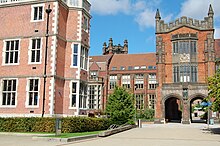

The university occupies a campus site close to Haymarket in central Newcastle upon Tyne. It is located to the northwest of the city centre between the open spaces of Leazes Park and the Town Moor.
The Armstrong building is the oldest building on the campus and is the site of the original Armstrong College. The building was constructed in three stages;[16] the north east wing was completed first at a cost of £18,000 and opened by Princess Louise on 5 November 1888. The south-east wing, which includes the Jubilee Tower, and south-west wings were opened in 1894. The Jubilee Tower was built with surplus funds raised from an Exhibition to mark Queen Victoria's Jubilee in 1887. The north-west front, forming the main entrance, was completed in 1906 and features two stone figures to represent science and the arts. Much of the later construction work was financed by Sir Isaac Lowthian Bell, the metallurgist and former Lord Mayor of Newcastle, after whom the main tower is named. In 1906 it was opened by King Edward VII.[17]
The building contains the King's Hall, which serves as the university's chief hall for ceremonial purposes where Congregation ceremonies are held. It can contain 500 seats.[18] King Edward VII gave permission to call the Great Hall, King's Hall.[17] During the First World War, the building was requisitioned by the War Office to create the 1st Northern General Hospital, a facility for the Royal Army Medical Corps to treat military casualties.[19][20] Graduation photographs are often taken in the University Quadrangle, next to the Armstrong building. In 1949 the Quadrangle was turned into a formal garden in memory of members of Newcastle University who gave their lives in the two World Wars.[21] In 2017, a statue of Martin Luther King Jr. was erected in the inner courtyard of the Armstrong Building, to celebrate the 50th anniversary of his honorary degree from the university.[22]
The Bruce Building is a former brewery, constructed between 1896 and 1900 on the site of the Hotspur Hotel, and designed by the architect Joseph Oswald[23] as the new premises of Newcastle Breweries Limited.[24][25] The university occupied the building from the 1950s, but, having been empty for some time, the building was refurbished in 2016 to become residential and office space.[26][27]
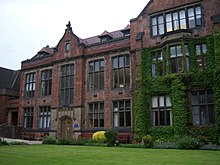
The Devonshire Building, opened in 2004, incorporates in an energy efficient design. It uses photovoltaic cells to help to power motorised shades that control the temperature of the building and geothermal heating coils. Its architects won awards in the Hadrian awards and the RICS Building of the Year Award 2004. The university won a Green Gown award for its construction.[28][29][30]
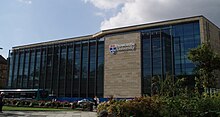
Plans for additions and improvements to the campus were made public in March 2008 and completed in 2010 at a cost of £200 million. They included a redevelopment of the south-east (Haymarket) façade with a five-storey King's Gate administration building as well as new student accommodation. Two additional buildings for the school of medicine were also built.[31] September 2012 saw the completion of the new buildings and facilities for INTO Newcastle University on the university campus. The main building provides 18 new teaching rooms, a Learning Resource Centre, a lecture theatre, science lab, administrative and academic offices and restaurant.
Newcastle's Library Service is the only one in the UK to be awarded the government's Charter Mark for excellent customer services five times in a row, together with a Customer Services Excellence award.[32] It consists of four main facilities. The Philip Robinson Library is the main university library and is named after a bookseller in the city and benefactor to the library. The Walton Library specialises in services for the Faculty of Medical Sciences in the Medical School. It is named after Lord Walton of Detchant, former Dean of the Faculty of Medicine and Professor of Neurology. The library has a relationship with the Northern region of the NHS allowing their staff to use the library for research and study. The Law Library specialises in resources relating to law, and the Marjorie Robinson Library Rooms offers additional study spaces and computers. Together, these house over one million books and 500,000 electronic resources. Some schools within the university, such as the School of Modern Languages, also have their own smaller libraries with smaller highly specialised collections.[33]
In addition to the city centre campus there are buildings such as the Dove Marine Laboratory located on Cullercoats Bay, and Cockle Park Farm in Northumberland.
Newcastle University Business School opened a London campus in September 2015.
International[]
In September 2008, the university's first overseas branch was opened in Singapore, a Marine International campus called, NUMI Singapore. This later expanded beyond marine subjects and became Newcastle University Singapore, largely through becoming an Overseas University Partner of Singapore Institute of Technology.[34]
In 2011, the Medical School opened a campus in Malaysia, Newcastle University Medicine Malaysia (NUMed).[35]
Organisation and governance[]
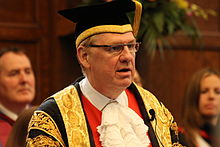
The current Chancellor is the British poet and artist Imtiaz Dharker. She assumed the position of Chancellor on 1 January 2020.[36] The vice-chancellor is Chris Day, a hepatologist and former pro-vice-chancellor of the Faculty of Medical Sciences.[37]
The university has an enrolment of almost 16,000 undergraduate and 5,600 postgraduate students from more than 120 countries. Teaching and research are delivered in 19 academic schools,[38] 13 research institutes and 38 research centres, spread across three Faculties: the Faculty of Humanities and Social Sciences; the Faculty of Medical Sciences; and the Faculty of Science, Agriculture and Engineering.[39] The university offers around 175 full-time undergraduate degree programmes in a wide range of subject areas spanning arts, sciences, engineering and medicine, together with approximately 340 postgraduate taught and research programmes across a range of disciplines.[40]
It holds a series of public lectures called 'Insights' each year in the Curtis Auditorium in the Herschel Building. Many of the university's partnerships with companies, like Red Hat, are housed in the Herschel Annex.[41]
Chancellors and Vice-Chancellors[]
Chancellors[]
|
Vice-Chancellors[]
|
Civic responsibility[]
The university describes itself as a civic university,[42] with a role to play in society by bringing its research to bear on issues faced by communities (local, national or international).
It is focusing a major part of its research into tackling three profound challenges facing global society; namely Ageing, Sustainability and Social Renewal.[43]
In 2012, the university opened the Newcastle Institute for Social Renewal[44] to address issues of social and economic change, representing the research-led academic schools across the Faculty of Humanities and Social Sciences[45] and the Business School.
Mark Shucksmith was Director of the Newcastle Institute for Social Renewal (NISR) at Newcastle University, where he is also Professor of Planning.[46]
Newcastle City Council has worked with the university to tackle local issues. One such is the issue to make public service cuts fair in times of austerity. Chris Brink, former Vice-Chancellor[47] at the university chaired the Newcastle Fairness Commission[48] to decide how the concept of 'fairness'[49] could be implemented with the full support of the community.
Newcastle was the only UK university to formally back the Jubilee Debt Campaign for the cancellation of debt in developing countries, and it has a strong ongoing commitment to the Make Poverty History campaign. At a high-profile honorary degree ceremony in January 2007, the university awarded honorary degrees to Bob Geldof, Gordon Brown MP, and Benjamin Mkapa (former president of Tanzania) among others, at an event that promoted debate on current debt-relief issues.[50]
In 2006, the university was granted fair trade status and from January 2007 it became a smoke-free campus.
The university has also been actively involved with several of the region's museums for many years. The Great North Museum: Hancock originally opened in 1884 and is often a venue for the university's events programme.[51]
Faculties and schools[]
Teaching schools within the university are based within three faculties. Each faculty is led by a Provost/Pro-vice-chancellor and a team of Deans with specific responsibilities.
|
|
|
National Innovation Centres[]
The University leads three National Innovation Centres:
- National Innovation Centre for Ageing
- National Innovation Centre for Data
- National Innovation Centre for Rural Enterprise
Business School[]
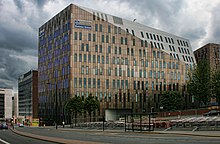
Newcastle University Business School has triple accreditation (AMBA, EQUIS, AACSB) placing it in the top 1% of business schools globally.[citation needed] The business school delivers world-class[citation needed] and innovative[citation needed] teaching.
In 2002, Newcastle University Business School established the Business Accounting and Finance or 'Flying Start' degree in association with the ICAEW and PricewaterhouseCoopers. The course offers an accelerated route towards the ACA Chartered Accountancy qualification and is the Business School's Flagship programme.[52] Its success has since resulted in Lancaster University and Ernst & Young collaborating to establish a competing degree programme in 2005.[53]
In 2011 the Business School opened their new building built on the former Scottish and Newcastle brewery site next to St James' Park.[54] This building was officially opened on 19 March 2012 by Lord Burns.[55]
Medical School[]

The Medical School gained 143 out of a possible 144 points in its six subject areas in the Teaching Quality Assessment, and was also the first institution in Europe, second in the world, to receive permission to pursue stem-cell research in human embryos.[citation needed] The BMC Medicine journal reported medical graduates from Oxford, Cambridge and Newcastle performed better in postgraduate tests than any other medical school in the UK.[56]
In 2008 the Medical School announced that they were expanding their campus to Malaysia.[35] In 2009 the university won a Queen's Anniversary Prize for their research into ageing.[57]
The Royal Victoria Infirmary has always had close links with the Faculty of Medical Sciences as a major teaching hospital.
School of Modern Languages[]
The School of Modern Languages consists of five sections: East Asian (which includes Japanese and Chinese); French; German; Spanish, Portuguese & Latin American Studies; and Translating & Interpreting Studies.[58] Six languages are taught from beginner's level to full degree level ‒ Chinese, Japanese, French, German, Spanish and Portuguese ‒ and beginner's courses in Catalan, Dutch, Italian and Quechua are also available. Beyond the learning of the languages themselves, Newcastle also places a great deal of emphasis on study and experience of the cultures of the countries where the languages taught are spoken. The School of Modern Languages hosts North East England's only branches of two internationally important institutes: the Camões Institute, a language institute for Portuguese, and the Confucius Institute, a language and cultural institute for Chinese.
The teaching of modern foreign languages at Newcastle predates the creation of Newcastle University itself, as in 1911 Armstrong College in Newcastle installed Albert George Latham, its first professor of modern languages.[59] Often in the School's history, the high quality of its teaching, research and student experience have been recognised. In the 2015 edition of the Guardian University Guide, the school was ranked 14 out of 63. In the 2014 edition of the Sunday Times Good University Guide, Iberian Studies, French and German in the School were each placed in the top ten for their subject across the UK. (East Asian Studies does not feature in this Guide.) In the 2013 National Student Survey, Spanish in the School came 6th in the UK for overall student satisfaction, and German came 7th.
The School of Modern Languages at Newcastle is also very active in outreach work. It is the Lead Institution in the North East Routes into Languages Consortium[60] and together with the Durham University, Northumbria University, the University of Sunderland, the Teesside University and a network of schools, undertakes work activities of discovery of languages for the 9 to 13 years pupils.[60] This implies having festivals, Q&A sessions, language tasters, or quizzes organised, as well as a web learning work aiming at constructing a web portal to link language learners across the region. There is a range of on-campus activities like the Linguacast On-Campus: 10 and 12 years pupils come and learn more about the practice and teaching of language; they visit Newcastle campus to produce Modern Foreign languages (MFL) web material and study it back in school. The SML provides structures from their linguistic communities so as to set up taster or revisions sessions.
The Language Days provide the 11 and 13 Years pupils the opportunity to immerse in core skill area in preparation for examinations. It also hosts, together with the School of Education, Communication and Language Sciences,[61] the North East Network for Languages regional centre.[62] Furthermore, the SML is the provider of the only German Extension Courses in the UK;[63] these courses are funded by the Department for Education.
Newcastle Law School[]
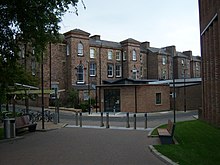
Newcastle Law School is the longest established law school in the north-east of England when law was taught at the university's predecessor college before it became independent from Durham University.[64][65] It has a number of recognised international and national experts in a variety of areas of legal scholarship ranging from Common and Chancery law, to International and European law, as well as contextual, socio-legal and theoretical legal studies.[65]
The Law School occupies four specially adapted late-Victorian town houses. The Staff Offices, the Alumni Lecture Theatre and seminar rooms as well as the Law Library are all located within the School buildings.[66]
School of Computing[]
The School of Computing undertakes a broad range of activity and is ranked in the Times Higher Education world Top 100.[67] Research areas include Human-Computer Interaction (HCI) and ubquitous computing, secure and resilient systems, synthetic biology, scalable computing (high performance systems, data science, machine learning and data visualization), and advanced modelling. The school was ranked first in the UK for impact of research in REF2014[68] and led the formation of the National Innovation Centre for Data.[69] Innovative teaching in the School was recognised in 2017 with the award of a National Teaching Fellowship.[70] The School hosts two EPSRC-funded Centres for Doctoral Training, in Cloud Computing for Big Data, and Digital Civics.
In 2017, the School relocated to the University's Urban Sciences Building on the Newcastle Helix Development.
Cavitation tunnel[]
Newcastle University has the second largest cavitation tunnel in the UK. Founded in 1950, and based in the Marine Science and Technology Department, the Emerson Cavitation Tunnel is used as a test basin for propellers, water turbines, underwater coatings and interaction of propellers with ice.[71] The Emerson Cavitation Tunnel was recently relocated to a new facility in Blyth.[72]
Museums and galleries[]


The university is associated with a number of the region's museums and galleries, including the Great North Museum project, which is primarily based at the world-renowned Hancock Museum. The Great North Museum: Hancock also contains the collections from two of the university's former museums, the Shefton Museum and the Museum of Antiquities, both now closed.[73] The university's Hatton Gallery is also a part of the Great North Museum project, and remains within the Fine Art Building.
Strengths[]
The University self-identifies five areas of particular strength:[74]
- Ageing and Health
- Cities and Place
- Culture and Creative Arts
- Data
- One Planet
Academic profile[]
Reputation and rankings[]
| National rankings | |
|---|---|
| Complete (2022)[75] | 23 |
| Guardian (2021)[76] | 51 |
| Times / Sunday Times (2021)[77] | 31= |
| Global rankings | |
| ARWU (2021)[78] | 201–300 |
| CWTS Leiden (2021)[79] | 78 |
| QS (2022)[80] | 134 |
| THE (2021)[81] | 171 |
| British Government assessment | |
| Teaching Excellence Framework[82] | Gold |
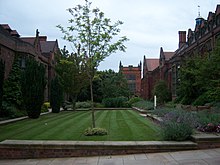
The university is a member of the Russell Group of the UK's research-intensive universities. It is ranked in the top 200 of most world rankings, and in the top 25 of most UK rankings. It is ranked 146th by QS,[83] 114th by Leiden[84] and joint 171st by Times Higher Education globally in 2018,[85] while nationally, it is ranked 21st by the Times/Sunday Times Good University Guide,[86] 22nd by the Complete University Guide[87] and 27th by the Guardian[88] for 2018. The majority of its undergraduate courses are ranked in the top 20 by the Complete University Guide in the country with a number of subjects ranked in the top 10 such as Dentistry (3rd), Medicine (9th), Architecture (5th), Linguistics (3rd) Art and Design (1st) and Communication and Media Studies (1st).[89] Newcastle University achieved the best possible outcome in the Teaching Excellence Framework (TEF) – a Gold Award.[90] The Times Higher Education Europe Teaching Rankings place Newcastle University joint 9th in Europe.[91] It was awarded 5 QS stars in 2013.[92] Newcastle won the Sunday Times University of the Year award in 2000 and is ranked 12th best in the UK by the Webometrics Ranking of World Universities.[93] According to the university, its library is the only one in the UK to have been awarded the government's Charter Mark for excellent customer services five times in a row.[94] Also, the university said it has a good track record for graduate employment in the country, and the Careers Service has won seven national careers awards in recent years by the Institute of Career Guidance.[95]
The university's Cochrane Park sports facility was a training venue for the teams playing football games at St James' Park for the 2012 London Olympics.[96] In 2013 the university entered into a two-year agreement with sports wear producer Adidas that includes scholarships and sportswear for two of the university's most talented athletes, and some funding for the Athletics' Union.[97]
In 2016, Newcastle University became one of 16 universities in the world, and only two in the UK, to achieve Five Plus Stars from Quacquarelli Symonds.[98] The university was awarded the perfect score of five Stars in all of the standardised assessment fields of Research, Internationalization, Facilities, Innovation, Inclusiveness, Specialist criteria and Student Employability (Newcastle University also made it to the Top 100 of QS Worldwide Employability Rankings in 2016).[99]
Admissions[]
| 2017 | 2016 | 2015 | 2014 | 2013 | |
|---|---|---|---|---|---|
| Applications[100] | 36,505 | 34,290 | 32,855 | 32,620 | 32,140 |
| Offer Rate (%)[101] | 87.9 | 88.3 | 92.1 | 86.7 | 85.1 |
| Enrols[102] | 6,205 | 6,175 | 5,650 | 5,200 | 5,255 |
| Yield (%) | 19.3 | 20.4 | 18.7 | 18.4 | 19.2 |
| Applicant/Enrolled Ratio | 5.88 | 5.55 | 5.82 | 6.27 | 6.12 |
| Average Entry Tariff[103][a] | n/a | 161 | 423 | 430 | 425 |
In terms of average UCAS points of entrants, Newcastle ranked joint 19th in Britain in 2014.[104] In 2015, the university gave offers of admission to 92.1% of its applicants, the highest amongst the Russell Group.[105]
25.1% of Newcastle's undergraduates are privately educated, the thirteenth highest proportion amongst mainstream British universities.[106] In the 2016–17 academic year, the university had a domicile breakdown of 74:5:21 of UK:EU:non-EU students respectively with a female to male ratio of 51:49.[107]
Research[]

Newcastle is a member of the prestigious Russell Group of 24 research-intensive universities. It was ranked joint 23rd in the UK amongst multi-faculty institutions for the quality (GPA) of its research[108] and 16th for its Research Power in the 2014 Research Excellence Framework.[109]
It is ranked 17th in the UK for research power, according to the influential publication, Research Fortnight, and is in the UK's top twelve for research power in science and engineering. The Research Excellence Framework 2014 placed Newcastle University; 1st in the UK for Computing Science research impact, 3rd in the UK for Civil Engineering research power and 11th in the UK for Mathematical Sciences research, 3rd in the UK for English, and in the top 12 for Geography, Architecture and Planning, and Cultural and Media Studies research quality, 4th amongst UK medical schools for Clinical Medicine research intensity.[110]
Student life[]
Students' Union[]

The university has many student organisations. Newcastle University Students' Union (NUSU), known as the Union Society until a 2012 rebranding, includes student-run sports clubs and societies.
Unlike the majority of other students' unions in the UK, Newcastle University Students' Union owns the building where it is housed. The Union building was built in 1924 following a generous gift from an anonymous donor, who is now believed to have been Sir Cecil Cochrane, a major benefactor to the university.[111] It is built in the neo-Jacobean style and was designed by the local architect Robert Burns Dick. It was opened on 22 October 1925 by the Rt. Hon. Lord Eustace Percy, who later served as Rector of King's College from 1937 to 1952. It is a Grade II listed building. In 2010 the university donated £8 million towards a redevelopment project for the Union Building.[112]
The Students' Union is run by seven paid sabbatical officers and ten part-time unpaid officer positions. The former leader of the Liberal Democrats Tim Farron was President of NUSU in 1991–1992. The Students' Union also employs around 300 people in ancillary roles including bar staff and entertainment organisers.
The Courier is a weekly student newspaper. Established in 1948, the current weekly readership is around 12,000, most of whom are students at the university. The Courier has won The Guardian's Student Publication of the Year award twice in a row, in 2012 and 2013.[113] It is published every Monday during term time.[114]
Newcastle Student Radio is a student radio station based in the university. It produces shows on music, news, talk and sport and aims to cater for a wide range of musical tastes.[115]
NUTV, known as TCTV from 2010 to 2017, is student television channel, first established in 2007. It produces live and on-demand content with coverage of events, as well as student-made programmes and shows.[116]
Student accommodation[]

Newcastle University has many catered and non-catered halls of residence available to first-year students, located around the city of Newcastle.[117] Popular Newcastle areas for private student houses and flats off campus include Jesmond, Heaton, Sandyford, Shieldfield, South Shields and Spital Tongues.
In 2008 a survey conducted by an independent website ranked Newcastle as the number one student city in the UK, with a score of 63% across the categories of going out, shops, transport, community and facilities.[118] Newcastle is also considered one of the world's friendliest cities.[119] In another 2008 survey, by MSN Travel, Newcastle was named as the number one university.[120]
St Mary's College in Fenham, one of the halls of residence, was formerly St Mary's College of Education, a teacher training college.
In 2019 private accommodation The Shield and Pitt Street Studios ranked 1st and 2nd in the Best in the UK for accommodation on a University review platform StudentCrowd.[121]
Sport[]
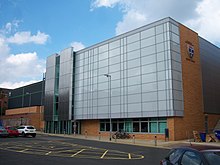
Newcastle is one of the leading universities for sport in the UK and is consistently ranked within the top 12 out of 152 higher education institutions in the British Universities and Colleges Sport (BUCS) rankings. More than 50 student-led sports clubs are supported through a team of professional staff and a network of indoor and outdoor sports facilities based over four sites.[122] The University have a strong rugby history and were the winners of the Northumberland Senior Cup in 1965.
The university enjoys a friendly sporting rivalry with local universities. The Stan Calvert Cup[123] was held between 1994 and 2018 by major sports teams from Newcastle and Northumbria University. The Northumbrian Water University Boat Race has also taken place between the rowing clubs of Newcastle and Durham University.[124]
Newcastle University F.C. currently compete in men's senior football in the Northern League Division Two.[125]
Alumni[]
Many notable and world-renowned alumni, including politicians, business people, academics, doctors, artists, authors, actors, musicians, and sports people graduated from Newcastle University.[126]
Student exchange[]
Newcastle University has signed over 100 agreements with foreign universities allowing for student exchange to take place reciprocally.[127]
See also[]
- List of Newcastle University people
- Russell Group
- Red Brick University
- Universities in the United Kingdom
- Rankings of universities in the United Kingdom
- List of universities in the United Kingdom
- Durham University
References[]
- ^ New UCAS Tariff system from 2016
- ^ Jump up to: a b c "Integrated Annual Report 2019–20" (PDF). Newcastle University. Retrieved 8 January 2021.
- ^ Gove, Jack (11 July 2016). "Newcastle University looks close to home for new v–c". Times Higher Education. TES Global. Retrieved 4 January 2017.
- ^ Jump up to: a b "Facts and Figures". Newcastle University. Archived from the original on 29 June 2014. Retrieved 25 May 2014.
- ^ Jump up to: a b c "Where do HE students study?". Higher Education Statistics Agency. Retrieved 1 March 2020.
- ^ "The Russell Group". The Russell Group. Retrieved 29 March 2008.
- ^ Eleanor Busby (6 June 2018). "Elite universities improve teaching scores after requesting to be judged again in government rankings". The Independent.
- ^ "Newcastle University – World University Rankings 2013–14". Times Higher Education. Retrieved 24 November 2013.
- ^ Andrews, Matthew Paul (2016). "Chapter 7 – Durham and Higher Education in Newcastle". Durham University: Last of the Ancient Universities and First of the New (1831-1871) (DPhil). University of Oxford. pp. 235–237.
- ^ Peter Vinten-Johansen, Howard Brody, Nigel Paneth, Stephen Rachman, Michael Rip, David Zuck (1 May 2003). Cholera, Chloroform, and the Science of Medicine: A Life of John Snow. Oxford University Press. p. 30. ISBN 9780199747887.CS1 maint: uses authors parameter (link)
- ^ Dennis Embleton (1890). Collegium Medicum Novocastrense : the history of the Medical School, afterwards the Durham College of Medicine at Newcastle-upon-Tyne, for forty years, from 1832 to 1872. Andrew Reid, Sons & Co. pp. 3–12.
- ^ Dennis Embleton (1890). Collegium Medicum Novocastrense : the history of the Medical School, afterwards the Durham College of Medicine at Newcastle-upon-Tyne, for forty years, from 1832 to 1872. Andrew Reid, Sons & Co. pp. 35, 52–53.
- ^ Dennis Embleton (1890). Collegium Medicum Novocastrense : the history of the Medical School, afterwards the Durham College of Medicine at Newcastle-upon-Tyne, for forty years, from 1832 to 1872. Andrew Reid, Sons & Co. pp. 60, 63–65.
- ^ Dennis Embleton (1890). Collegium Medicum Novocastrense : the history of the Medical School, afterwards the Durham College of Medicine at Newcastle-upon-Tyne, for forty years, from 1832 to 1872. Andrew Reid, Sons & Co. pp. 75, 92.
- ^ "Linguistics Association of Great Britain Conference 2006". Newcastle University. Archived from the original on 8 December 2007. Retrieved 29 March 2008.
- ^ "Universities of Durham and Newcastle upon Tyne Act 1963" (PDF). Newcastle University. Archived from the original (PDF) on 5 July 2010. Retrieved 7 October 2010.
- ^ "The Armstrong Building". Heritage Open Days. Archived from the original on 4 September 2015. Retrieved 1 May 2015.
- ^ Jump up to: a b "Royal opening for student services building". Newcastle University. 4 February 2010. Archived from the original on 9 February 2010. Retrieved 4 February 2010.
- ^ "King's Hall". Newcastle University. Archived from the original on 7 March 2009. Retrieved 23 March 2009.
- ^ "Newcastle's War Hospitals". Heaton History Group. Retrieved 21 July 2019.
- ^ "Newcastle's fascinating First World War tales are explored in new book". The Chronicle. 28 July 2015. Retrieved 25 March 2018.
- ^ "Quadrangle". Newcastle University. 2009. Archived from the original on 16 November 2009. Retrieved 27 August 2009.
- ^ "Statue unveiled in honour of Martin Luther King Jr". 13 November 2017. Retrieved 16 January 2020.
- ^ Lynn Pearson (1999). British Breweries: An Architectural History. A&C Black. pp. 183–. ISBN 978-1-85285-191-0.
- ^ "The Bruce Building". SINE Project. 8 July 2003. Archived from the original on 26 January 2010. Retrieved 3 December 2008.
- ^ Bennison, Brian; Merrison, James P (1990). A Centenary History of the Newcastle Breweries.
- ^ "Revamp plans for former brewery HQ unearths relic of WWII". The Journal. 27 February 2014. Retrieved 30 April 2015.
- ^ "The Bruce Building". Walton Robinson. Retrieved 8 December 2018.
- ^ "Devonshire Building – The Hadrian Awards". Dewjoc Architects. Archived from the original on 2 June 2007. Retrieved 2 November 2008.
- ^ "Accolade for Devonshire Building". Newcastle University. Archived from the original on 17 June 2011. Retrieved 2 November 2008.
- ^ "Devonshire Building praised by HEFCE". Newcastle University. Archived from the original on 20 September 2005. Retrieved 2 November 2008.
- ^ "Newcastle University announces £200 million investment in its campus". Newcastle University. 26 March 2008. Archived from the original on 23 December 2012. Retrieved 6 April 2008.
- ^ "Charter Mark". Newcastle University. Archived from the original on 2 October 2008. Retrieved 1 September 2008.
- ^ "Library". Newcastle University School of Computing Science. Retrieved 19 September 2010.
- ^ "Singapore Institute of Technology Overseas University Partners". Singapore Institute of Technology. 2017. Retrieved 1 September 2017.
- ^ Jump up to: a b "NUMed Malaysia". Newcastle University Medicine Malaysia. 2009. Retrieved 29 May 2009.
- ^ Jump up to: a b "Renowned poet Imtiaz Dharker named new Chancellor". Newcastle University. Retrieved 8 January 2020.
- ^ Whitfield, Graeme. "Newcastle University appoints top medic as its new vice-chancellor". Trinity Mirror. Retrieved 4 January 2017.
- ^ "Teaching and Research". Newcastle University. 2018. Retrieved 27 June 2018.
- ^ "Research Directory". Newcastle University. 2018. Retrieved 27 June 2018.
- ^ "University Structure". Newcastle University. Archived from the original on 28 June 2014. Retrieved 25 May 2014.
- ^ "Global computing giant joins forces with Newcastle". Newcastle University. 3 March 2010. Archived from the original on 6 March 2010. Retrieved 14 March 2010.
- ^ Newcastle University. "Newcastle University: A Civic University". Archived from the original on 12 December 2012. Retrieved 26 November 2012.
- ^ Newcastle University. "Societal Challenge Themes". Archived from the original on 8 November 2012. Retrieved 26 November 2012.
- ^ Newcastle University. "Newcastle Institute for Social Renewal". Archived from the original on 2 November 2012. Retrieved 26 November 2012.
- ^ Newcastle University. "Faculty of Humanities and Social Sciences". Retrieved 26 November 2012.
- ^ Newcastle University. "Director of the Newcastle Institute for Social Renewal". Archived from the original on 31 October 2012. Retrieved 26 November 2012.
- ^ Elmes, John (25 November 2015). "Newcastle University vice-chancellor to retire next year". Times Higher Education. Retrieved 4 January 2017.
- ^ Newcastle University. "Newcastle Fairness Commission". Archived from the original on 15 December 2012. Retrieved 26 November 2012.
- ^ Brink, Chris (24 July 2012). "How to make public services cuts fairer". The Guardian. Retrieved 26 November 2012.
- ^ "Debt campaigners honoured by Newcastle University". Jubilee Debt Campaign. 8 January 2007. Archived from the original on 24 June 2008. Retrieved 7 June 2008.
- ^ "Museums". Newcastle University. Retrieved 10 October 2010.
- ^ "Flying Start Degree Programme". Newcastle University. Archived from the original on 15 September 2008. Retrieved 15 August 2008.
- ^ "The Ernst & Young Degree". Lancaster University. Archived from the original on 2 February 2006. Retrieved 15 August 2008.
- ^ "Newcastle University Business School Opens New £50m Building". Sky News Tyne and Wear. 19 March 2012. Archived from the original on 21 July 2012. Retrieved 7 May 2012.
- ^ "Lord Burns opens new Newcastle University Business School building". The Journal. 20 March 2012. Archived from the original on 1 May 2013. Retrieved 7 May 2012.
- ^ "Call for medical training reform". BBC News. 18 February 2008. Retrieved 1 April 2008.
- ^ "Ageing research wins Queen's Anniversary Prize". Newcastle University. 18 November 2009. Archived from the original on 25 January 2010. Retrieved 7 April 2010.
- ^ "School of Modern Languages". Newcastle University. Retrieved 21 August 2013.
- ^ "School of Modern Languages History" (PDF). Newcastle University. Archived from the original (PDF) on 14 May 2012. Retrieved 23 August 2013.
- ^ Jump up to: a b "North East". Routes into Languages Consortium. Retrieved 21 August 2013.
- ^ "School of Education, Communication and Language Sciences". Newcastle University. Retrieved 21 August 2013.
- ^ "North East Network for Languages regional centre". Retrieved 22 August 2013.
- ^ "German Extension Courses". Newcastle University. Archived from the original on 29 July 2012. Retrieved 21 August 2013.
- ^ "History – Newcastle Law School". Newcastle University.
- ^ Jump up to: a b "The Newcastle Law School". Newcastle University. 2 January 2008. Retrieved 29 March 2008.
- ^ "The Newcastle Law School". Newcastle University. 2 January 2008. Archived from the original on 23 November 2011. Retrieved 20 June 2011.
- ^ "Computer Science 2018 | Times Higher Education (THE)". Times Higher Education. Retrieved 25 March 2018.
- ^ "Results & submissions : REF 2014 : View results and submissions by UOA". Results.ref.ac.uk. Retrieved 25 March 2018.
- ^ "New National Innovation Center – Press Office – Newcastle University". Ncl.ac.uk. Retrieved 25 March 2018.
- ^ "National Teaching Fellow – Press Office – Newcastle University". Ncl.ac.uk. Retrieved 25 March 2018.
- ^ "Emerson Cavitation Tunnel History" (PDF). Newcastle University School of Marine Science and Technology. Retrieved 29 August 2008.
- ^ "Research tunnel moving to Blyth to make way for new social space". The Courier Online. Archived from the original (webpage) on 18 January 2017. Retrieved 14 January 2017.
- ^ "Our History (Great North Museum)". Tyne and Wear Museums. 2009. Archived from the original on 19 February 2009. Retrieved 30 May 2009.
- ^ "Newcastle University - Who we are - Our Strengths". Newcastle University. Newcastle University. Retrieved 27 November 2020.
- ^ "Complete University Guide 2022". The Complete University Guide. 8 June 2021.
- ^ "Guardian University Guide 2021". The Guardian. 5 September 2020.
- ^ "Good University Guide 2021". The Times.
- ^ "Academic Ranking of World Universities 2021". Shanghai Ranking Consultancy. 15 August 2021.
- ^ "CWTS Leiden Ranking 2021 – PP top 10%". CWTS Leiden Ranking.
- ^ "QS World University Rankings 2022". Quacquarelli Symonds Ltd.
- ^ "THE World University Rankings 2021". Times Higher Education.
- ^ "Teaching Excellence Framework outcomes". Higher Education Funding Council for England.
- ^ "QS World University Rankings® 2020". Top Universities. Retrieved 30 July 2019.
- ^ "CWTS Leiden Ranking". Leiden University. Retrieved 7 July 2020.
- ^ "World University Rankings 2018". Times Higher Education. TES Global. Retrieved 28 September 2018.
- ^ "The Times and Sunday Times Good University Guide 2019". The Times and Sunday Times. Retrieved 24 September 2018.
- ^ "The Complete University Guide". The Complete University Guide. Retrieved 1 June 2018.
- ^ "University league tables 2019". The Guardian Students. Guardian News and Media Limited. Retrieved 1 June 2018.
- ^ "University League Tables 2018". The Complete University Guide. The Complete University Guide. Retrieved 8 May 2017.
- ^ Dickinson, Katie. "North East universities ranked in new teaching assessment – here's how they did". Chronicle Live. Trinity Mirror. Retrieved 24 August 2017.
- ^ Bothwell, Ellie. "THE Europe Teaching Rankings 2018: results announced". Times Higher Education. TES Global. Retrieved 16 July 2018.
- ^ "Current Rankings". Newcastle University. Archived from the original on 3 December 2013. Retrieved 24 November 2013.
- ^ "Top Universities in the UK". Webometrics Ranking of The World. Retrieved 23 August 2014.
- ^ "Library Gains Prestigious 5th Charter Mark Award". Newcastle University. Archived from the original on 18 March 2008. Retrieved 29 March 2008.
- ^ "National award for Careers Service". Newcastle University. 15 September 2004. Archived from the original on 8 December 2007. Retrieved 29 March 2008.
- ^ "Newcastle University named Olympic 2012 training venue". BBC News. 23 March 2011. Retrieved 23 March 2011.
- ^ "Newcastle University students on track to benefit from adidas deal". Newcastle University. Archived from the original on 21 May 2013. Retrieved 16 April 2013.
- ^ "QS Stars University Ratings". 8 May 2014. Retrieved 29 June 2016.
- ^ "QS Intelligence Unit | QS Graduate Employability Rankings – Year 2016 (Pilot)". www.iu.qs.com. Retrieved 29 June 2016.
- ^ "End of Cycle 2017 Data Resources DR4_001_03 Applications by provider". UCAS. UCAS. 2017. Retrieved 25 January 2018.
- ^ "Sex, area background and ethnic group: N21 Newcastle University". UCAS. UCAS. 2017. Retrieved 25 January 2018.
- ^ "End of Cycle 2017 Data Resources DR4_001_02 Main scheme acceptances by provider". UCAS. UCAS. 2017. Retrieved 25 January 2018.
- ^ "Top UK University League Table and Rankings". Complete University Guide.
- ^ "University League Table 2017". Complete University Guide. Retrieved 15 February 2016.
- ^ "Which elite universities have the highest offer rates". The Daily Telegraph. Retrieved 21 October 2016.
- ^ "Widening participation: UK Performance Indicators 2016/17". hesa.ac.uk. Higher Education Statistics Authority. Retrieved 1 February 2018.
- ^ "Where do HE students study?". hesa.ac.uk. Higher Education Statistics Authority. Retrieved 9 February 2018.
- ^ "Research Excellence Framework results 2014" (PDF).
- ^ "REF 2014 results". The Guardian. Retrieved 24 March 2015.
- ^ "Newcastle University". Times Higher Education. Retrieved 29 June 2018.
- ^ Bettenson, E (1971). The University of Newcastle upon Tyne: a historical introduction, 1834–1971. University of Newcastle upon Tyne. ISBN 0-900565-32-2.
- ^ "Newcastle University building revamp starts". BBC News. 7 November 2010.
- ^ About the Courier – www.thecourieronline.co.uk. Retrieved 19 February 2019.
- ^ "Contact us". The Courier. Archived from the original on 12 March 2010. Retrieved 12 March 2010.
- ^ "NSR – Newcastle Student Radio".
- ^ "NUTV". Newcastle University Students' Union. Retrieved 10 January 2018.
- ^ "List of Accommodation Sites". Newcastle University. 13 March 2007. Archived from the original on 17 April 2007. Retrieved 17 May 2007.
- ^ "Newcastle named best university town in Britain". Newcastle University. 19 June 2008. Archived from the original on 7 July 2008. Retrieved 15 July 2008.
- ^ "Best Student Accommodation in Newcastle". Best Student Halls. Retrieved 13 December 2015.
- ^ "1. Newcastle". MSN Travel. 2008. Archived from the original on 22 August 2008. Retrieved 12 January 2009.
- ^ https://www.studentcrowd.com/article/top-50-uk-student-halls-accommodation-value-for-money-2019[bare URL]
- ^ "European success for Newcastle University rowing teams". Newcastle University. 2013. Archived from the original on 6 January 2014. Retrieved 6 January 2014.
- ^ "Stan Calvert". Union Society. Archived from the original on 31 August 2011. Retrieved 23 September 2010.
- ^ "The University Boat Race". Newcastle University. Archived from the original on 3 May 2008. Retrieved 7 June 2008.
- ^ "Newcastle University". Northern League. 28 June 2019. Retrieved 14 July 2019.
- ^ "The Alumni Association". Newcastle University. 2009. Retrieved 29 May 2009.
- ^ "Outgoing exchanges". Newcastle University. 2020. Retrieved 22 October 2020.
External links[]
| Wikimedia Commons has media related to University of Newcastle upon Tyne. |
- Newcastle University
- Buildings and structures in Newcastle upon Tyne
- Russell Group
- Educational institutions established in 1834
- Exempt charities
- 1834 establishments in England
- Tourist attractions in Newcastle upon Tyne
- Universities UK

